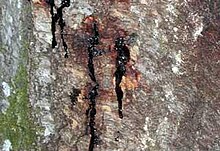
Back Phytophthora ramorum Catalan Fytoftorové odumírání Czech Clwyf marwol sydyn y derw Welsh Phytophthora ramorum German Phytophthora ramorum Spanish Tamme-äkksurm Estonian Versopolte Finnish Phytophthora ramorum French Phytophthora ramorum Dutch Phytophthora ramorum Polish
| Phytophthora ramorum | |
|---|---|

| |
| Canker on an infected oak | |
| Scientific classification | |
| Domain: | Eukaryota |
| Clade: | Diaphoretickes |
| Clade: | SAR |
| Clade: | Stramenopiles |
| Phylum: | Oomycota |
| Order: | Peronosporales |
| Family: | Peronosporaceae |
| Genus: | Phytophthora |
| Species: | P. ramorum
|
| Binomial name | |
| Phytophthora ramorum Werres et al. 2001
| |
Phytophthora ramorum is the oomycete known to cause the disease sudden oak death (SOD). The disease kills oak and other species of trees and has had devastating effects on the oak populations in California and Oregon, as well as being present in Europe. Symptoms include bleeding cankers on the tree's trunk and dieback of the foliage, in many cases leading to the death of the tree.
P. ramorum also infects a great number of other plant species, significantly woody ornamentals such as Rhododendron, Viburnum, and Pieris, causing foliar symptoms known as ramorum dieback or ramorum blight. Such plants can act as a source of inoculum for new infections, with the pathogen producing spores that can be transmitted by rainsplash and rainwater.
P. ramorum was first reported in 1995, and the origins of the pathogen are still unclear, but most evidence suggests it was introduced as an exotic species to Europe and North America in separate events.[1] Very few control mechanisms exist for the disease, and they rely upon early detection and proper disposal of infected plant material.
- ^ Grünwald, N. J.; Garbelotto, M.; Goss, E. M.; Heungens, K.; Prospero, S. (2012). "Emergence of the sudden oak death pathogen Phytophthora ramorum". Trends in Microbiology. 20 (3): 131–138. doi:10.1016/j.tim.2011.12.006. PMID 22326131.